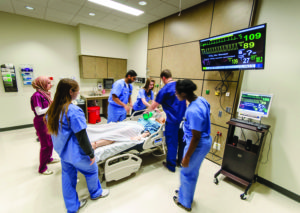Technology Integration Series
-
Category
Innovation -
Posted By
Lisa Gomperts -
Posted On
Jan 26, 2016
Schmidt Associates has developed a two part series on technology integration in a healthcare educational environment including: technology basics, its impact on an overall campus, and specific implementation in a new medical school and medical research environment.
Technology Basics in Healthcare Education and Research
Technology has become a huge recruiting tool for healthcare programs at universities and for healthcare careers. Why? Simply because of the benefits that it has on an educational and professional experience. For example, technology allows healthcare students to simulate real life situations using mannequins without jeopardizing patient safety.

Marian University COM Simulation Lab
With the current generation of students that universities are serving, technology is such an integral part of their lifestyle. We stress to our clients that they need to equip this generation of students with the tools they are familiar with as well as the advanced technology they will see in their future professional careers. Students these days think through technology, it is the institution’s educational responsibility to equip them with these tools.
Since technology changes every 6-12 months, Schmidt Associates often recommends to our clients to bid the technology scope separate from the construction project. Doing so allows the client to procure the most current and up-to-date technology equipment just before occupancy of the building.
In sum, technology has a huge role in advancing institution’s curriculums and courses in order to fully prepare students for what’s ahead. It also plays a critical role in attracting and retaining professionals once they enter the workforce.
Healthcare Technology Impacts on the Overall Campus
Integrating technology into advanced healthcare programs will ultimately have a dramatic impact on the overall campus-wide setting. In order to make sure that the software and new technology fits in with both the healthcare program’s goals and the institutional goals, it is extremely important the technology leadership group, as well as the campus leadership group, is involved in the project planning. This allows you to understand what the institution currently has and why, so that you can successfully integrate the new technologies within that premise.
It’s also important to understand the different programs being served and how the new technologies can have a positive or potentially negative impact on them. For example, when Schmidt Associates was working with Marian University on their new School of Osteopathic Medicine, we found the integration of the new medical school technology was so advanced that it led to an elevation of technology throughout the entire campus. With this came a need for additional staff, expanded campus fiber infrastructure, and new technology protocols. Although this resulted in additional expense to the University, the overall result was a more robust technology infrastructure that provides better access to its faculty, staff, and student body.







